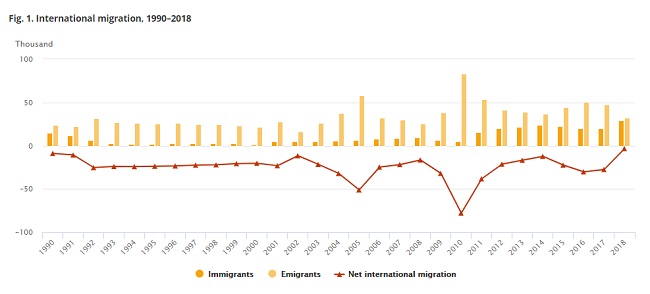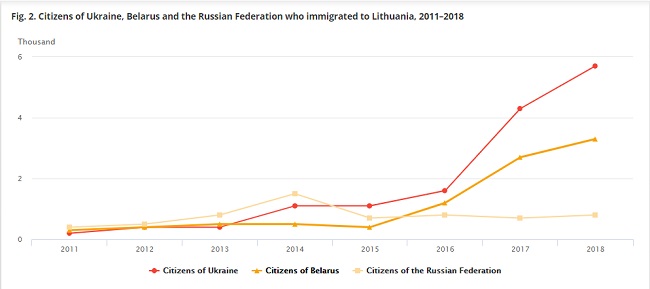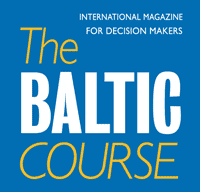Analytics, Demography, Lithuania, Statistics
International Internet Magazine. Baltic States news & analytics
Sunday, 11.05.2025, 04:56
International migration of the Lithuanian population
 Print version
Print version- In
2018, 32.2 thousand residents emigrated from Lithuania. Compared to
2017, the number of emigrants decreased 1.5 times, or by
15.7 thousand.
- In
2018, the number of emigrants exceeded that of immigrants by
3.3 thousand. This is the lowest net international migration indicator
since 1990.
Fig. 1. International migration, 1990–2018

- In
2018, the number of male and female emigrants amounted to 17 thousand
and 15.2 thousand respectively, i.e. the number of male emigrants
exceeded that of female emigrants by 1.8 thousand. Over the year, the
number of emigrants per 1000 population decreased from 16.9 to 11.5.
- The
majority (72.9 %) of emigrants declared
their departure to the EU countries.
- In
2018, most residents of Lithuania chose the following countries as their
destination of emigration:
The United Kingdom – 12.2 thousand (37.7%), i.e.
1.8 times less than in 2017.
Germany – 3.2 thousand (9.8%), i.e. by 23.4%
less than in 2017.
Norway – 3 thousand (9.3%), i.e. 1.7
times less than in 2017.
Ireland – 2 thousand (6.3%), i.e. 1.7 times
less than in 2017.
- The
majority (83.8%) of emigrants were born in Lithuania, 3.5% – in Ukraine,
3.2% – in Russia, 2.2% – in the United Kingdom, 1.9% – in Belarus.
- More
than half of male (67.2%) and female (57.6%) emigrants aged 18 and older
had never been married, a quarter – were married.
- In
2018, the average
age of the male and female emigrants was 26 years.
- In
2018, the number of male and female immigrants amounted to
20 thousand and 8.9 thousand respectively. Over the year, the
number of immigrants per
1000 population increased from 7.2 to 10.3.
- In
2018, 16.6 thousand of citizens of the Republic of Lithuania returned
to Lithuania, which is by 6.4 thousand more than in 2017. More than
half (57.1%) of them were men.
- In
2018, the majority of the citizens of the Republic of Lithuania who
returned to Lithuania came back from:
The United Kingdom – 7.6 thousand, or 45.8%.
Norway – 1.9 thousand, or 11.3%.
Ireland – 1.2 thousand, or 7.4 %.
Germany – 1.2 thousand, or 7.3 %.
- Compared
to 2017, the number of citizens of the Republic of Lithuania who returned
from the United Kingdom and Ireland grew 1.5 times, from Norway and
Germany – 1.9 times from each.
- In
2018, the average
age of male and female citizens of the Republic of Lithuania who
returned to Lithuania was 29 and 28 years respectively.
- In
2018, 12.3 thousand foreigners immigrated to the country (42.6%
of all immigrants), which is by 2.1 thousand (20.7%) more than
in 2017. The majority (85.3%) of foreigners who immigrated to
Lithuania were men.
- Almost half (5.7 thousand, or 46.5%) of foreigners who immigrated to Lithuania in 2018 were the citizens of Ukraine, 3.3 thousand (26.4%) – Belarus, 780 (6.3%) – the Russian Federation.
- Over
the year, the number of citizens of Ukraine who immigrated to Lithuania
grew by 32.1%, Belarus – 20%, the Russian Federation – 18.9 %.
Fig. 2. Citizens of Ukraine, Belarus and the Russian Federation who
immigrated to Lithuania, 2011–2018
Thousand

More information is available in the Database
of Indicators.
Definitions :
Immigrant — a person who has arrived in a
country with the intention to stay in the new place for permanent residence, or
longer than 6 months. It may also be an alien having a temporary residence
permit for a year and longer.








 «The Baltic Course» Is Sold and Stays in Business!
«The Baltic Course» Is Sold and Stays in Business!

